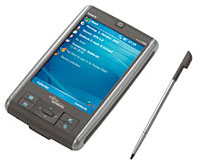 Fujitsu Siemens have launched the “first handhelds with fully integrated GPS functionality”, the Pocket LOOX N500 and Pocket LOOX N520 PDAs.
Fujitsu Siemens have launched the “first handhelds with fully integrated GPS functionality”, the Pocket LOOX N500 and Pocket LOOX N520 PDAs.
Delivered with Microsoft Windows Mobile 5.0 and optional NAVIGON MobileNavigator 5, the new LOOX models offer an integrated SiRFStar III GPS Receiver for GPS functionality, making them “robust without compromising on design”.
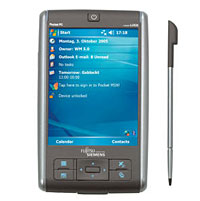 Powered by an Intel XScale PXA270 312 MHz CPU, the devices come with a SD/MMC slot (with support for SDIO), USB 1.1, IrDA and Bluetooth, with the Pocket LOOX N520 offering integrated wireless LAN 802.11g Wi-Fi.
Powered by an Intel XScale PXA270 312 MHz CPU, the devices come with a SD/MMC slot (with support for SDIO), USB 1.1, IrDA and Bluetooth, with the Pocket LOOX N520 offering integrated wireless LAN 802.11g Wi-Fi.
Both units offer a large 3.5″ screen (active area: 53×71 mm) with a resolution of 240×320 pixels, 64K colours and 10 levels of backlighting brightness, supported by 64Mb RAM and 64Mb flash memory (LOOX N500) and 128Mb (LOOX N520).
The attractively finished silver and slate grey LOOX devices come with a removable Li-Ion 1200 mAh battery which should provide something like 16 hours of MP3 playback.
A new Persistent Memory feature has also been added, providing secure storage for programmes and documents when the power gets low.
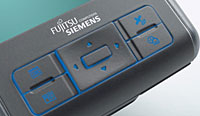 There’s also a ton of Fujitsu Siemens-branded applications bundled in the package, including Voice recorder, AudioPath and Key Look, along with a Microsoft Mobile suite including Excel, Power Point, Outlook and Internet Explorer.
There’s also a ton of Fujitsu Siemens-branded applications bundled in the package, including Voice recorder, AudioPath and Key Look, along with a Microsoft Mobile suite including Excel, Power Point, Outlook and Internet Explorer.
They’re not the smallest PDAs on the market, with pocket-straining dimensions of 116x71x14 mm (bigger than the previous LOOX 420 model) and a weight of 160g, but they do come with a cool blue illuminated keypad and base station with headphones.
Both handhelds are available now from £239.00 (~US$434, €351~) and £259.00 (~US$459, €381~) respectively (excluding VAT).
 A Hong Kong doleboy has been slapped down by The Man after he was found guilty of distributing three Hollywood films using BitTorrent’s peer-to-peer file sharing technology.
A Hong Kong doleboy has been slapped down by The Man after he was found guilty of distributing three Hollywood films using BitTorrent’s peer-to-peer file sharing technology. The OpenSource BitTorrent software has become one of the most popular means of downloading large files, with the technology allowing users to download fragments of a large file from multiple users, rather than in one hefty lump.
The OpenSource BitTorrent software has become one of the most popular means of downloading large files, with the technology allowing users to download fragments of a large file from multiple users, rather than in one hefty lump. BT is planning to turbo-boost broadband connectivity by quadrupling basic connectivity speeds to 8mbps nationwide and giving the service a snappy name, “ADSL Broadband Max”.
BT is planning to turbo-boost broadband connectivity by quadrupling basic connectivity speeds to 8mbps nationwide and giving the service a snappy name, “ADSL Broadband Max”.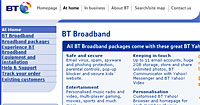 The 8mbps service will see BT reaching the theoretical top ADSL speeds it announced when the broadband service first launched in 2000.
The 8mbps service will see BT reaching the theoretical top ADSL speeds it announced when the broadband service first launched in 2000. With the industry rapidly consolidating, BT is coming under increasing pressure from newly merged uber-telecos like Telewest/NTL and Sky/Easynet, with the former already offering speeds of more than 8mbps for no extra charge on existing broadband subscriptions.
With the industry rapidly consolidating, BT is coming under increasing pressure from newly merged uber-telecos like Telewest/NTL and Sky/Easynet, with the former already offering speeds of more than 8mbps for no extra charge on existing broadband subscriptions. Elsewhere, BT has started trialling optical fibre broadband services in Wales, connecting business to ultra-high-bandwidth services using strands of blown fibre run along using existing telegraph poles.
Elsewhere, BT has started trialling optical fibre broadband services in Wales, connecting business to ultra-high-bandwidth services using strands of blown fibre run along using existing telegraph poles. Released today in Korea, the land where they get all the cool gadgets first, Samsung’s new SCH V700 handset has the honour of being the first PMP (Portable Media Player) phone in the world.
Released today in Korea, the land where they get all the cool gadgets first, Samsung’s new SCH V700 handset has the honour of being the first PMP (Portable Media Player) phone in the world.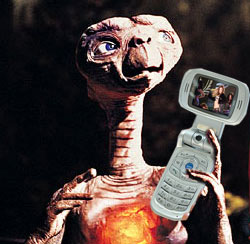 The V700 comes in Samsung’s favoured clamshell design with the added twist of a tilting display which lets users rotate the screen 90 degrees to take advantage of a wider display (it looks a bit like ET to us in this position, but maybe we’ve been overdoing it a bit recently.)
The V700 comes in Samsung’s favoured clamshell design with the added twist of a tilting display which lets users rotate the screen 90 degrees to take advantage of a wider display (it looks a bit like ET to us in this position, but maybe we’ve been overdoing it a bit recently.) We’re impressed with the onboard TV out port which could prive a great way of sharing your photos with chums.
We’re impressed with the onboard TV out port which could prive a great way of sharing your photos with chums.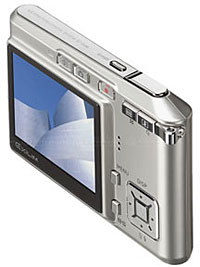 CASIO have announced their new, wafer-thin EXILIM CARD EX-S600 digital camera.
CASIO have announced their new, wafer-thin EXILIM CARD EX-S600 digital camera.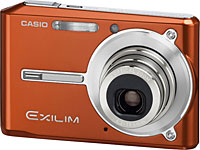 According to Casio’s announcement, Revive Shot mode “adjusts for obliquity as well as brightly refreshes faded colours.”
According to Casio’s announcement, Revive Shot mode “adjusts for obliquity as well as brightly refreshes faded colours.” As is de rigeur on consumer compacts, there’s a built in movie mode with the Casio capturing MPEG-4, VGA (640×480 pixels) at 30 frames/second.
As is de rigeur on consumer compacts, there’s a built in movie mode with the Casio capturing MPEG-4, VGA (640×480 pixels) at 30 frames/second.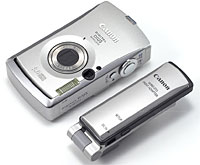 Canon are trumpeting that they are “bringing IXUS style and performance to the wireless age” with the release of their PowerShot camera.
Canon are trumpeting that they are “bringing IXUS style and performance to the wireless age” with the release of their PowerShot camera.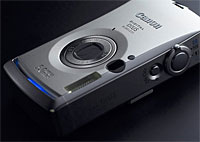 The camera can be registered with up to 8 target devices including wireless access points via a secure communication system to prevent eavesdropping or interception of your photographic masterpieces.
The camera can be registered with up to 8 target devices including wireless access points via a secure communication system to prevent eavesdropping or interception of your photographic masterpieces.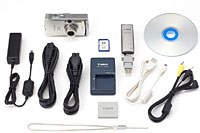 Although we naturally warm to the convenience and sheer ‘techiness’ of Wi-Fi enabled digital cameras, we remain to be convinced that the technology has reached maturity yet.
Although we naturally warm to the convenience and sheer ‘techiness’ of Wi-Fi enabled digital cameras, we remain to be convinced that the technology has reached maturity yet. We speak from some experience here too, after foolishly being seduced by Sony’s innovative – but frankly pointless – Bluetooth feature on its 20002 DSC FX77 camera.
We speak from some experience here too, after foolishly being seduced by Sony’s innovative – but frankly pointless – Bluetooth feature on its 20002 DSC FX77 camera. More details about Jason Tomczak’s class action against Apple for releasing defective iPod Nanos have emerged on The Inquirer’s site.
More details about Jason Tomczak’s class action against Apple for releasing defective iPod Nanos have emerged on The Inquirer’s site.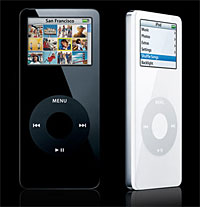 The plaintiff alleges that with Steve Jobs whipping the Nano out of his pocket in a TV advert, Apple led consumers to believe the machine was durable.
The plaintiff alleges that with Steve Jobs whipping the Nano out of his pocket in a TV advert, Apple led consumers to believe the machine was durable.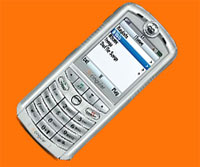 Ironically, things haven’t been helped by the iPod nano appearing on the scene straight after the phone’s launch, with the ultra-small pocket rocket holding 10 times the amount of songs for half the price
Ironically, things haven’t been helped by the iPod nano appearing on the scene straight after the phone’s launch, with the ultra-small pocket rocket holding 10 times the amount of songs for half the price The portable game business will be worth a thumping great $2.3 billion in four years, according to a report released today by research firm, The Yankee Group.
The portable game business will be worth a thumping great $2.3 billion in four years, according to a report released today by research firm, The Yankee Group.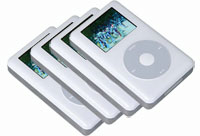 With the line between wireless handsets and portable CE devices continuing to blur, the Yankee Group used data from both their Video Capable Device Survey and the Mobile User Survey to come up with what they describe as “the most comprehensive view into the portable device market.”
With the line between wireless handsets and portable CE devices continuing to blur, the Yankee Group used data from both their Video Capable Device Survey and the Mobile User Survey to come up with what they describe as “the most comprehensive view into the portable device market.”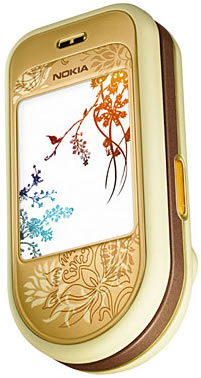 Mobile phone giants Nokia have announced three new phone models aimed at the “style-conscious” market.
Mobile phone giants Nokia have announced three new phone models aimed at the “style-conscious” market.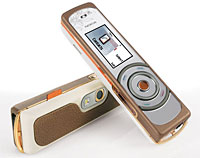 Desperately described as a phone for “trend-setting men and women who enjoy being the centre of attention,” the highly distinctive 7380 looks like it’s come from the same bonkers design studio as the
Desperately described as a phone for “trend-setting men and women who enjoy being the centre of attention,” the highly distinctive 7380 looks like it’s come from the same bonkers design studio as the 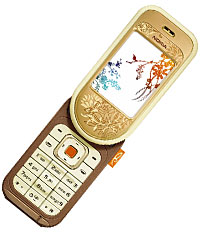 Employing a sliding keypad, the Nokia 7370 comes with a 2-inch QVGA colour screen (320 x 240 pixels), stereo speakers with 3D sound effects and a 1.3 megapixel camera (8x zoom) onboard.
Employing a sliding keypad, the Nokia 7370 comes with a 2-inch QVGA colour screen (320 x 240 pixels), stereo speakers with 3D sound effects and a 1.3 megapixel camera (8x zoom) onboard.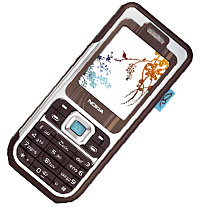 Nokia 7360
Nokia 7360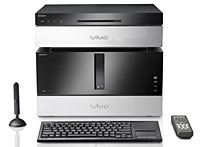 Sony are keen for us to ‘redefine’ our living rooms with the release of their new VAIO XL1 Digital Living System, a twin box offering combining a high-end multimedia PC with a 200-disc media changer/recorder.
Sony are keen for us to ‘redefine’ our living rooms with the release of their new VAIO XL1 Digital Living System, a twin box offering combining a high-end multimedia PC with a 200-disc media changer/recorder.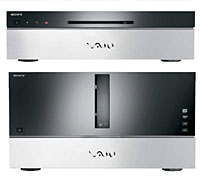 A similar process takes place for movies, where an in-depth synopsis and star, cast, director and producer details etc are automatically downloaded and made accessible onscreen through the included wireless keyboard or remote control.
A similar process takes place for movies, where an in-depth synopsis and star, cast, director and producer details etc are automatically downloaded and made accessible onscreen through the included wireless keyboard or remote control. There’s no denying that the recording functionality seems mighty impressive to us, with the XL1 able to automatically and sequentially record up to 200 audio CDs from the media changer to the hard drive.
There’s no denying that the recording functionality seems mighty impressive to us, with the XL1 able to automatically and sequentially record up to 200 audio CDs from the media changer to the hard drive.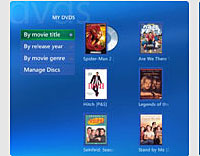 To ensure that your late night listening pleasure isn’t spoilt by the sound of a mass of Boeing 747-like fans starting up, the XL1 system uses liquid-cooled components for quiet operation.
To ensure that your late night listening pleasure isn’t spoilt by the sound of a mass of Boeing 747-like fans starting up, the XL1 system uses liquid-cooled components for quiet operation.